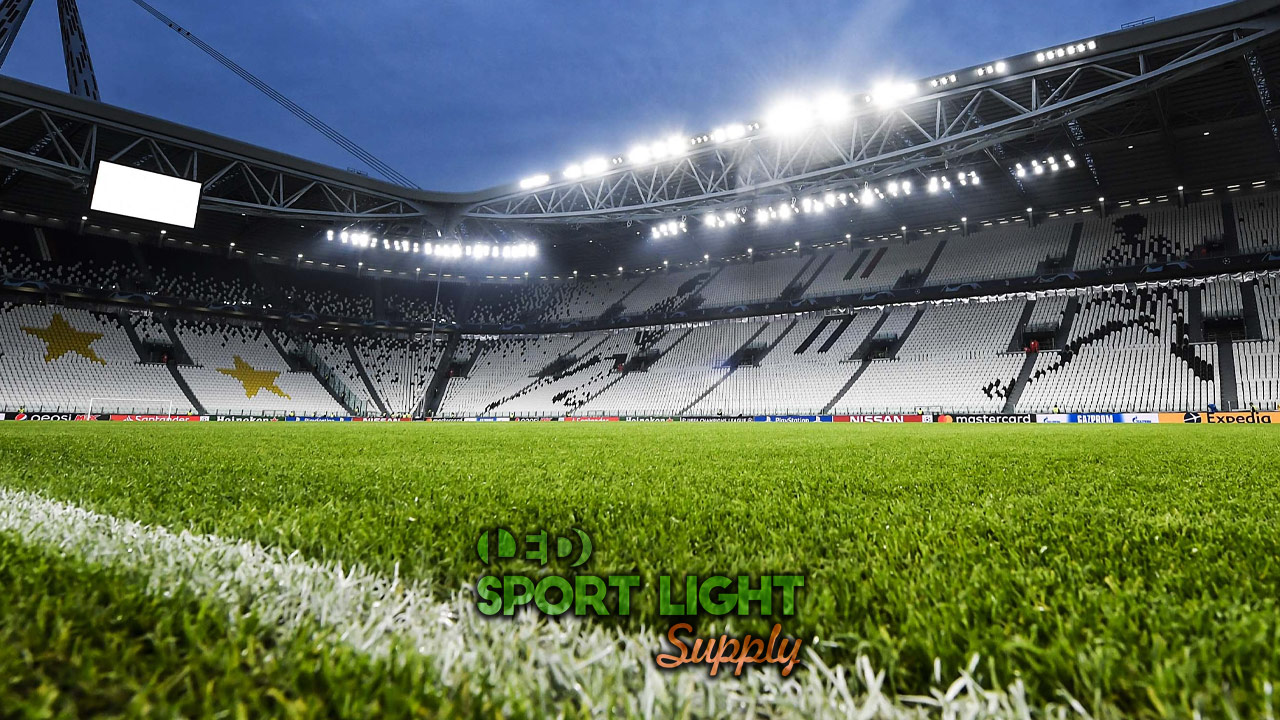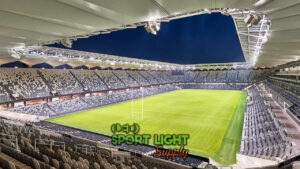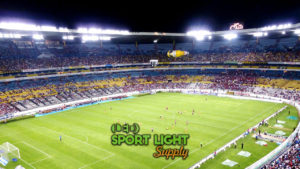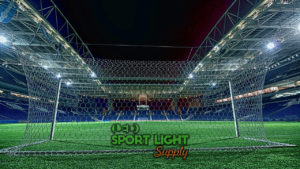Advantages of replacing stadium lights
1. LED efficiently replaces metal halide football stadium lights
Back in the old days, metal halide lamps were the cream of the cream. But today, LED lights provide a better lighting quality. Plus, LED stands out due to the following perks:
- no warm up time
- more energy saving (lower wattage)
- no cool down period
- savings in running costs and maintenance (better overall design)
An HID stadium light may contain radioactive substances such as thorium. In detail, thorium helps to reduce the MH bulb starting time. But the typical metal halide lamp still needs up to 15 minutes to fully reach its full light output. Instead, LED lights light up immediately. In short, LEDs are more reliable and suitable as football stadium lights.
2. LED safely replaces mercury vapor bulbs
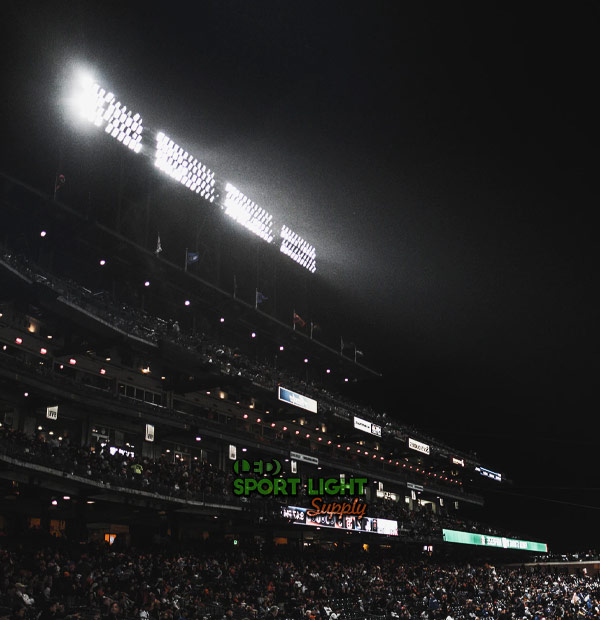 The mercury vapor that may escape from a broken bulb is highly dangerous. To be precise, inhalation of mercury vapors in humans causes acute intoxication. Permanent damage to the nervous system and death are possible effects as well.
The mercury vapor that may escape from a broken bulb is highly dangerous. To be precise, inhalation of mercury vapors in humans causes acute intoxication. Permanent damage to the nervous system and death are possible effects as well.
Chronic intoxication, called mercurialism, insidiously affects the nervous system. Above all, the toxic effects cannot be observed until months after exposure.
LED prevents any adverse consequence of using mercury vapor bulbs because:
- it contains no toxic mercury
- no flickering in LEDs means that you do not need to replace them all the time
- no LED retrofit produces ultraviolet radiation
3. LED replaces high pressure sodium stadium lamps
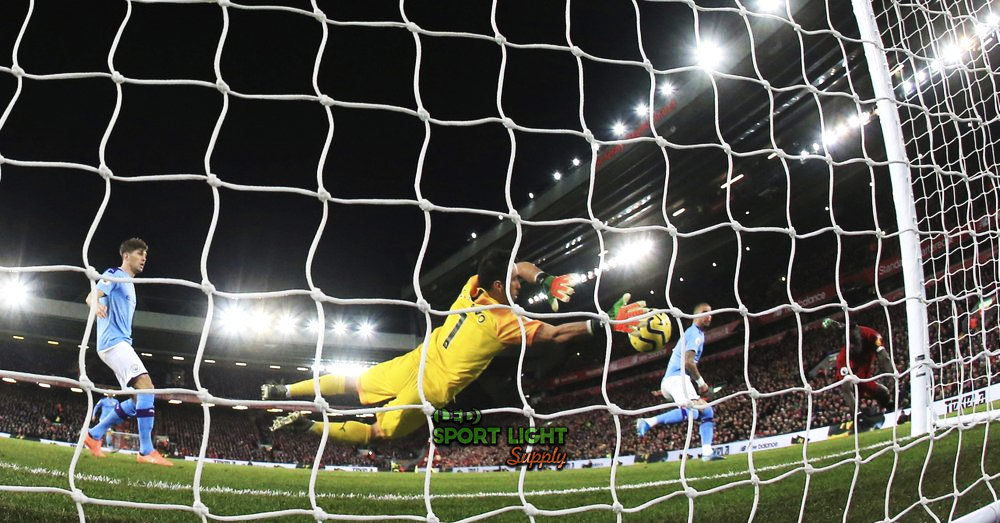
An operating HPS lamp has a low CRI <60. But LED lights have a high CRI of 85+, which is more suitable for FIFA world cup/Premier League matches.
HPS lamps emit a large amount of heat. Consequently, an adequate ventilation system is required. Instead, no LED replacement heats up that much.
When you convert a high pressure sodium stadium system to an LED one, you make a long-lasting investment. In fact, HPS lamps are among the HID lights with the shortest life span of all.
Lastly, you do not need new ballasts for the retrofit installation. LED lights do not need a ballast or a starter. So, unlike HPS bulbs, they are easy to move, switch, and upgrade.
How to replace metal halide stadium lights with LED?
1. Lumens of metal halide lamps
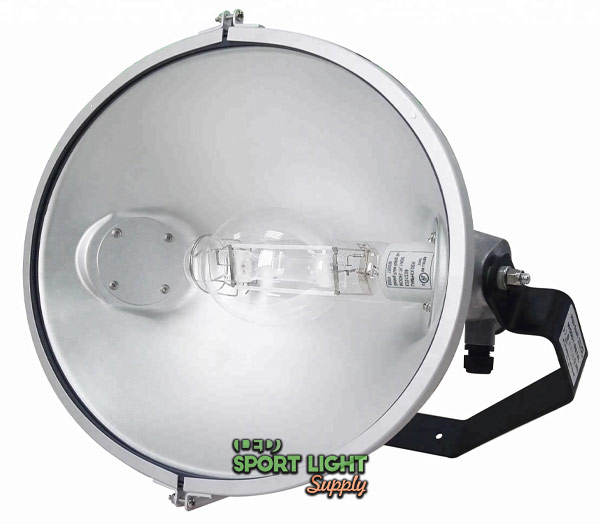 Each HID lamp type has a different lumen output. In this case, the metal halide lamp’s maximum light intensity per unit area. You need to find out how many lumens your MH bulbs emit before you can convert the old lighting system to a LED one.
Each HID lamp type has a different lumen output. In this case, the metal halide lamp’s maximum light intensity per unit area. You need to find out how many lumens your MH bulbs emit before you can convert the old lighting system to a LED one.
Usually, a stadium light has the model name printed on the fixture base. Use that name or code to find out the technical sheet of the product. Once you retrieved the initial lumen value, you can start looking for a LED replacement. Just filter out the products with fewer lumens.
2. Common wattages of metal halide replacements
If you did not manage to find the lumen value, here are some popular wattages to help you find an equivalent LED replacement.
- 400W (40,000-50,000 lumens)
- 1,000W (130,000-140,000 lumens)
- 1,500W (190,000-200,000 lumens)
- 2,000W (270,000-280,000 lumens)
Wattage is not useful to replace your HID light because it reveals to you the power consumption only. For example, a 2000W grow room LED light may emit a far lower lumen output than a 2000W football stadium LED lights. Mainly because of the different purposes and features. So, try to find the metal halide lamp lumen value in any way for the best results.
3. Wattage equivalent of MH lamps
Most LED lights will make you save at least one-third of your electricity bill. For example, you can retrofit a 1000W metal halide flood light by installing a 300-600W LED. This is possible because every HID bulb depreciates in lumens over time.
If you were the initial lumens of a new 1000W MH to find an equivalent LED replacement, you would find that the LED wattage slightly increases.
Depending on the bulb quality, an MH light source can emit 50 to 80 lumens per watt. Instead, LEDs have a lumen efficiency of up to 140 lumens per watt.
4. Beam angle
Most LED products let you choose a precise beam angle. In detail, you can choose between a wide beam angle (120 or higher) or a narrow one (less than 60). Of course, several LED lights offer varying beam angles in between. Some products such as flood lights and spot lights may come with accessories to further control the luminous flux.
Mostly, metal halide flood lights used shutters and shielding. But these accessory types could lead to disservices and even injuries. Mainly due to the hot light source or installation height. Instead, LED lighting provides remote control: you can even use your smartphone to control each lighting body with most models.
5. Bulb base

When shopping for the equivalent LED bulb, make sure you select the right screw base. As a matter of fact, most HID lights have a mogul or goliath base. This means that you must find a LED retrofit with an E39 or E40 screw base. Otherwise, you will not be able to screw in the LED replacement.
By all means, you can retrofit any LED light, really. Even if they have another screw base type. But in that case, you need to purchase an adapter. As you can imagine, you need an adapter with an E39 (or E40) to your lamp’s screw-base converter. The adapter works as an additional lamp holder. So, make sure it can fit in the casing as it can take up space.
6. Input voltage
When retrofitting a LED light where an old MH lamp used to be, you should be aware of the input voltage difference. HID lamps need a ballast to work. In detail, ballasts and igniters are essential components for discharge lamp ignition, such as metal halide bulbs.
However, your LED retrofit does not need a ballast at all. If anything, the ballast can only damage a LED light. In fact, it provides way too high voltage for any LED lamp. LEDs can work with voltages as low as 12v. But every product may have a precise voltage range for optimal performances. In that case, select an adequate driver. That is, a device that connects to the LED retrofit and changes the operating frequency.
7. Ballast issue
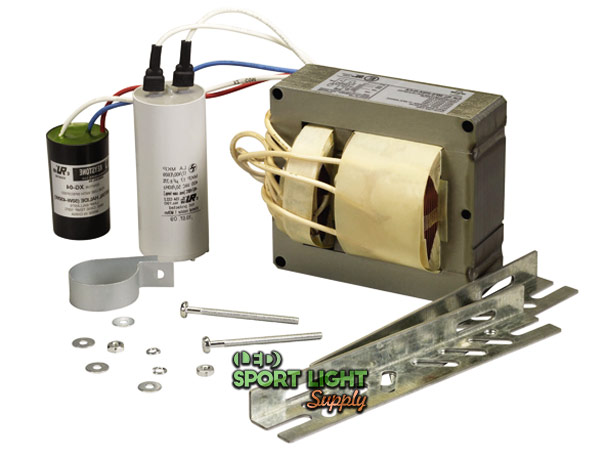 When you replace a metal halide stadium light with a LED retrofit, you might find no ballast. In this case, you are probably looking at self-ballasted models. To explain, the ballast is inside the metal halide lamp base. Generally speaking, most self-ballasted MH lamps operate on 110/220Vac or 230/240V.
When you replace a metal halide stadium light with a LED retrofit, you might find no ballast. In this case, you are probably looking at self-ballasted models. To explain, the ballast is inside the metal halide lamp base. Generally speaking, most self-ballasted MH lamps operate on 110/220Vac or 230/240V.
If the HID lamp operated on Vac voltage, you need Vac compatible LED drivers to install LED replacements. In reality, most LED lights will run on any voltage below 270Vac. But in case of doubts, ask the reseller for guidance.
For standard metal halide bulbs, remove the ballast to convert the lamp holder and casing to the new LED lighting system.
How to replace mercury vapor football field lights with LED?
1. Lighting system
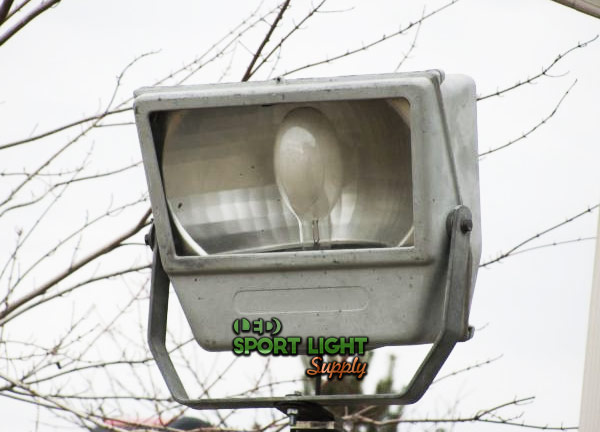 Most of the time, mercury vapor football field lights used specific casings and housings for protection. Gas-discharge lamps were mostly installed for street lighting. So, many manufacturers created industrial fittings that offer little or no space for installing a LED retrofit with a driver. In that case, you might be better off replacing the lamp holder as well.
Most of the time, mercury vapor football field lights used specific casings and housings for protection. Gas-discharge lamps were mostly installed for street lighting. So, many manufacturers created industrial fittings that offer little or no space for installing a LED retrofit with a driver. In that case, you might be better off replacing the lamp holder as well.
If you decide to keep the mercury vapor lamp socket, remember to find the ballast first. In most instances, the ballast should be placed next to the bulb. But in later models, they might have been installed elsewhere. The latest models are self-ballasted.
2. Lumens of mercury vapor lights
Due to their low light efficiency (less than 60 Lumen/Watt), mercury vapor lights are easy to replace.
The standard 1000 watt mercury vapor lamp produces 58,000 lumens at best. Then again, one barely reaches the 25,000 hours in total.
Its lumen output drops considerably after the first 5,000 hours. So, virtually any stadium LED light for professional use will do. In fact, even the cheapest 500W LED spot light still delivers 66,000 lumens.
If you plan to host several football events and championships in your stadium, consider reading the association’s guidelines for better lighting.
3. Common wattage of mercury vapor replacements
You should replace your mercury vapor lamp with a LED light that consumes at least half of its wattage. If you cannot figure out the lumen output of an old mercury vapor bulb, read the fine print on the screw base. Usually, it will show you the wattage.
You can assume that a mercury vapor lumen output is anywhere between 40 and 60. In this way, you can get an idea of its luminous efficiency by multiplying 40-60 by its wattage.
With a 1,000W LED retrofit, you can replace a 2,000W mercury vapor lamp. If you need to replace a gas-discharge lamp bulb that consumes less than 2,000W, a 500W LED light should do.
4. Color temperature
A stadium mercury vapor light emits a bluish light. In technical terms, the light color shade is called color temperature. Commonly, you find it expressed in the specs data under the “color temperature” entry.
Today, you can find several LED lights with varying hues. If you want to keep the same color temperature, you will have to select a cold white LED light. That is, a color temperature higher than 5,500 K.
Be aware that most sports lighting requirements such as FIFA’s regulations advise against using color temperatures higher than 7,000 K.
5. Safety recommendations
The installation of mercury vapor replacements follows the same rules as any other LED retrofit installation. But keep in mind that mercury vapor lamps are dangerous.
Not only do you have to make sure that the bulb does not crack, but you also have to recycle it correctly. Disposal due to mercury in the lamp requires the intervention of a solid waste district specialist. Contact your local municipality for more info. Especially in the case of a mercury spill.
Lastly, make sure to wear gloves to avoid leaving fingerprints on the bulb. The fat residue from the skin may crack the glass bulb in case of a new ignition.
How to replace HPS with LED stadium lights?
1. Lumens of high pressure sodium bulbs
For many years, HPS lights have provided a satisfying illuminance in most playing areas. Wildly popular until recent times, the latest models managed to breach the 150 lumens per watt ratio.
Unlike other HID lamps, HPS bulbs produce a reddish-orange light spectrum (2,000 K). Their arc tubes reach very high temperatures. For the most part, you find them in outdoor environments, such as stadiums and parking lots.
Most commercial 1,000-watt high pressure sodium lights ensure between 110,000 and 130,000 lumens. Since the appearance of LED lights, most manufacturers discontinued the production of HPS bulbs with higher wattages.
2. Common wattage of HPS replacements
Every year or so, LED tech advances over HPS. Today, the new generation of LED retrofit models offer a more reliable system for the sports industry.
Without a doubt, a 600W LED light is the most common replacement of conventional 1,000W HPS fixtures.
Thanks to LEDs’ lower heat emission, better positioning becomes available as well. Similarly, operators can move spot lights more efficiently and safely.
A single row of 2,000W LED lights running around the ceiling is also a viable lighting solution for modern lighting layouts. Especially in domed stadiums and hybrid half dome coverings.
3. Product specifications
The many downsides of high pressure sodium include a low CRI. In fact, you cannot easily find an HPS bulb with a Color Rendering Index of more than 40. To specify, CRI is a value that informs you of the realistic looks of the illuminated object. The higher the CRI rating, the better the outcome.
For televised events, you need high-power stadium lights that provide at least 90 CRI. So, make sure to replace the old HPS with an efficient LED light.
Also, take note of the HPS bulb’s lifespan as this product contains mercury. Therefore, you should dispose of it correctly before any potential incidents due to overheating.
4. Bypass the ballast for retrofit installations
Before removing the high pressure sodium bulb to convert the fixture to LED, you need to let it cool down and bypass the ballast. First of all, turn the electricity off.
Most LED products let you bypass the ferromagnetic ballast and igniter at the same time. Just cut the hot and neutral cables and follow the instruction manual provided by the manufacturer. Usually, you only need to connect the input hot and neutral wires to the respective output ones.
Of course, the suggestions about the previous HID’s ballast removal still apply.
Common mistakes when retrofitting the LED stadium lights
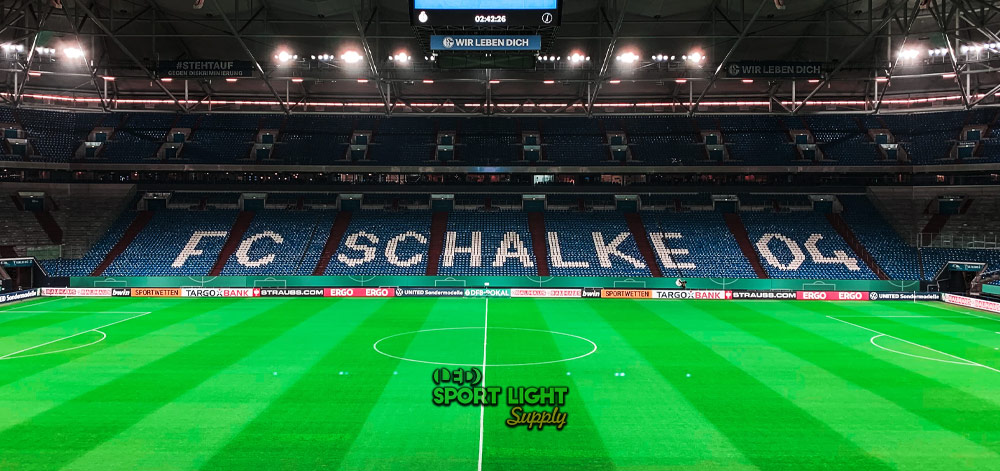
1. Using the wrong power
It is common knowledge that you cannot just compare the wattage of old HID lights and new LED lights. Instead, you need to look at the lumen output of the old and new lights.
Looking up the lamp’s model is the fastest way to find out the lumen output and select an equivalent replacement. Alternatively, you should follow your association’s lighting regulations.
Today, most football stadium fixtures use 2,000 watts LED lights. In fact, they need to provide an adequate lux level for the football matches. Once you know the required lux level for your stadium, you can calculate every LED retrofit’s necessary lumen output.
2. Omitting the beam angle
The old lights have a specific beam angle. So, the new LED replacements should have more-or-less the same beamwidth. Also, it is strongly recommended to adopt the new DIALux lighting design. In this way, finding out what beam angle and lumens are required becomes easy and profitable.
DIALux is a renowned lighting design software that helps you achieve optimal lighting performance. Every modern sports arena needs a retrofit installation due to its high energy consumption.
By calculating the exact beam angle for each light fixture, it is possible to further reduce the energy demand. As a result, you can save on the fitting purchases as well. Mostly by selecting more products with a specific (often narrow) beam angle.
3. Incorrect input voltage
When the input voltage is wrong, the LED retrofit absorbs more energy. The higher voltage can cause overheating of the wires that power and run in the lamp holder or adapter.
Voltage absorption changes because of the LED semiconductor resistance. This means that it does not matter if the replacement consumes more or fewer watts than the old HID lamp. You need to know and provide the suitable input voltage for the replacement to work correctly.
Each light fitting may have a different input voltage. That is why many LED retrofit products come with a dedicated driver. Finally, you still need to consider the heat generated by the LED lamp. Overvoltage means that the LED sports light heats up more, so it could damage any plastic nearby. Or the casing of a ceiling light.
4. Weight of stadium lights
Some light poles may not tolerate the new weight of the lights. So, you need to check if the new lighting fixtures are too heavy.
Size can be deceiving, especially when you do not consider the driver’s weight as well. When you replace a mercury vapor lamp, select a fully assembled LED retrofit system.
Before you fully renovate the whole stadium lighting system, convert just one HID light. Inspect the light pole for any sign of tilting or vertical angle deviation.
Most high masts are placed several feet and meters away from the sidelines. But a fallen fixture still poses a safety hazard due to glass shards and the possibility of fires during the hot seasons.

